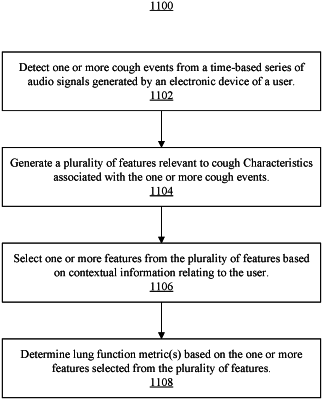| CPC G16H 50/30 (2018.01) [G06N 20/00 (2019.01); G10L 25/24 (2013.01); G10L 25/66 (2013.01); G16H 10/60 (2018.01); G16H 20/30 (2018.01)] | 18 Claims |

|
1. A method within and by a computer hardware system including a hardware processor, comprising:
passively monitoring a time series of audio signals generated by a microphone of the computer hardware system for a cough event by a user;
filtering, by a cough detector within the hardware processor, portions of the audio signals that do not relate to the cough event to generate filtered audio signals;
generating, by a feature vector generator, a cough feature vector corresponding to the filtered audio signals, wherein each element of the cough feature vector corresponds to one or more of a plurality of audio signal features extracted from the filtered audio signals, wherein the plurality of audio signal features includes mean value of mel-frequency cepstral coefficients (MFCCs) and skewness of MFCCs; and
generating, by a regressor implemented by the hardware processor, a predicted lung function metric of the user based on the cough feature vector;
wherein the computer hardware system includes a feature vector optimizer configured to select particular ones of the plurality of audio signal features as extracted from the filtered audio signals for inclusion into the cough feature vector based upon one or more biodemographic factors of the user including a health status of the user.
|
|
18. A method within and by a computer hardware system including a hardware processor, comprising:
passively monitoring a time series of audio signals generated by a microphone of the computer hardware system for a cough event by a user;
filtering, by a cough detector within the hardware processor, portions of the audio signals that do not relate to the cough event to generate filtered audio signals;
generating, by a feature vector generator, a cough feature vector corresponding to the filtered audio signals, wherein each element of the cough feature vector corresponds to an audio signal feature extracted from the filtered audio signals; and
generating, by a regressor implemented by the hardware processor, a predicted lung function metric of the user based on the cough feature vector;
wherein the cough detector includes a cough segmenter configured to extract edges of a burst phase of the cough event and reject non-burst portions of the cough event, and the cough feature vector is generated only based upon the burst phase of the cough event.
|